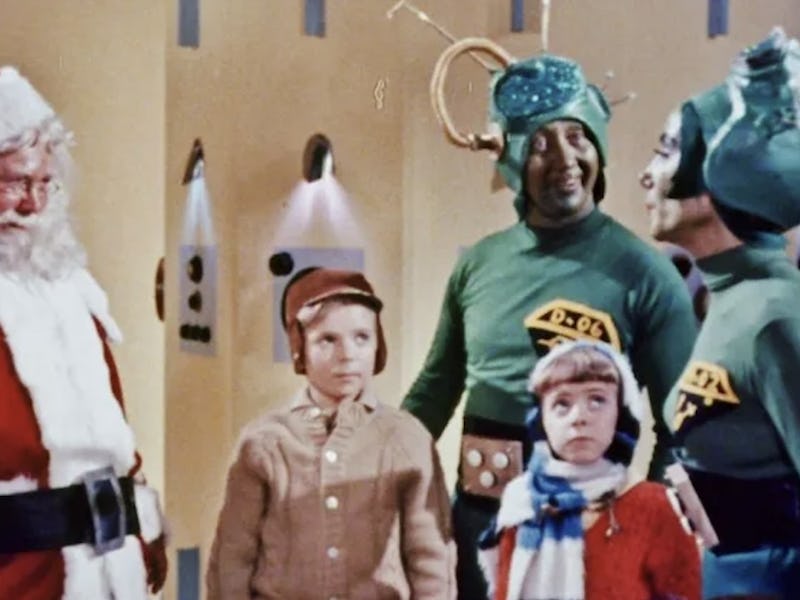Your Holidays Won’t Be Complete Without the Campiest Sci-Fi Movie Ever
Visit Mars this Christmas.

The famously terrible auteur Ed Wood never lent his distinctive talents to a Christmas film, but with its truly baffling sci-fi narrative, accidental sense of high camp, and special effects that appear to have been rustled up by the nearest kindergarten class, Santa Claus Conquers the Martians is the next best thing.
The “Worst Films Ever” list regular, which is celebrating its 60th birthday, has an unusually solid pedigree. Just three years earlier, director Nicholas Webster had picked up an Emmy nod for his ABC documentary Walk In My Shoes. Meanwhile, the cast was littered with respected actors from the theater world: John Call, who played Santa, came straight from the original Broadway staging of Oliver, while Bill McCutcheon, here the film’s groan-worthy comic relief character, Dropo, would later earn a Tony. It even gave a screen debut to future Golden Globe winner Pia Zadora, seen here as a 10-year-old Martian addicted to Earth-made TV.
It’s the latter which sets the film’s unhinged wheels in motion. Perturbed by his kids turning into couch potatoes, Kimar (Leonard Hicks) consults Chochem (Carl Don), an 800-year-old sage who theorizes their society’s joyless way of life may be to blame. Mars doesn’t allow autonomous thought (machines feed information directly into citizens’ brains), while food (even burgers and chocolate cake) is consumed in miserly pill form.
What the youth needs, according to the Yoda-like presence, is a figure who shakes his belly like a bowlful of jelly. Of course, the Red Planet, which appears to solely consist of the Martian family’s flimsy home and a giant cave, doesn’t have anyone who fits that mold. So, along with various sidekicks, including boo-hiss baddie Voldar (Vincent Beck), Kimar decides the only course of action is to kidnap the real thing.
In one of the film’s few intentional laughs, the Martians are left bamboozled when they descend to Earth and discover that Santa Claus has countless doppelgangers. Adding to their rap sheet, the motley crew abducts human children Billy (Victor Stiles) and Betty (Donna Conforti) to help track down the genuine Santa. If that wasn’t traumatic enough, the poor mites are also nearly mauled by the most unconvincing polar bear ever committed to celluloid. “We weren’t about to get a real bear,” Webster later argued about what’s obviously a man in a suit.
A man in a cardboard box, aka oversized robot Torg, and cinema’s first Mrs. Claus.
The costume designer (or “custume designer,” as the opening credits state in a foreshadowing of the sloppiness to come) wasn’t the only amateur on board. You can clearly see one of the elves moving when they‘re supposed to have been magically frozen by the nefarious Voldar. The spaceship that transports the kidnappers to Earth and back again seems to have been constructed from upcycled cardboard. And complementing their cheap helmets and tin foil antennas, the Martians’ blotchy green make-up was surely applied in the dark.
Still, Santa Claus Conquers the Martians is nothing if not resourceful. The cutaways to the American military, who mistake the alien visitors for a Soviet aircraft, borrow the same stock footage used in Stanley Kubrick’s slightly more acclaimed Dr. Strangelove. And after playing an 800-year-old philosopher, Don gets to show his range by doubling up as the scientist who bizarrely refers to the aliens as “Martian monkeys.”
Like Ed Wood’s finest, the cult favorite also has a so-bad-it’s-good charm. There’s something almost subversive about the way Call chooses to portray Santa; one minute, he’s playing the befuddled old man (“Prancer and Dancer and Donder and Blixen and Vixen and Nixon and, uh... Oh consarnit, I get those names mixed up”), the next he’s cracking henpecked husband jokes at the expense of Mrs Claus (Doris Rich in, remarkably, the character’s first cinematic depiction), and then he’s laughing like a maniacal villain during a literal, and surprisingly trippy, toy fight. He also seems remarkably nonchalant about being bundled into a spacecraft, transported to an alien planet, and consigned into forced labor.
Vincent Beck’s baddie Voldar and his forever twirling mustache.
Furthermore, Beck is clearly having a blast as the Martians’ inner saboteur, and for those who find all the comedic antics tiresome, he’s the voice of reason, too; see his visible disdain for Santa’s joke, (“What’s gooey, green, and you roast it on the end of a stick? A Martian-mallow!”) and the fit of hysterics it’s greeted with. And it’s hard to disagree with the Grinch’s concerns on first meeting the gormless Billy and Betty (“Is this what you want to do to our children? Turn them into nincompoops like these?”).
Of course, like any great pantomime villain, his master plan is woefully ineffective. While he repeatedly expresses his wish to murder Santa (and the two humans brought along for the ride), Voldar does little more than change the toy factory settings, which results in a teddy bear/doll hybrid. By the end of the slim 81-minute run time, he’s in Martian jail, the three abductees are on their way home, and village idiot Dropo has been appointed as Mars’ new joy-spreading savior.
The film’s classic piece of trash legacy has since been bolstered by several stage adaptations and affectionate mockeries from sources like Mystery Science Theater 3000. There was even talk of a Jim Carrey-led remake back in the ‘90s. Santa Claus Conquers the Martians is objectively terrible, to be clear. But in an era saturated by Hallmark’s formulaic schmaltzfests, there’s something strangely endearing about a Christmas film so hopelessly homemade.